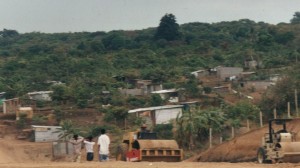
There are no peripheries in Managua, Nicaragua, since there’s no center. Through the whole urban sprawl, the “spontaneous settlements” (slums) and the “colonies” (gated towns) live close together, the first protected by its gangs, the others by private guards. The government doesn’t make any effort to hide the misery of its poorest population: Nicaragua lives of selling to the world its poverty, by catching funds from international cooperation, most of which ends up in the hands of the elites.
Many NGOs that now work in the enormous number of projects of “integral development” or “community empowerment” in the poorest neighborhoods of Managua, are the same organizations that in the eighties offered international and often armed solidarity to the Sandinista Revolution, against the “dirty war” financed by the US government. Now they are being financed by the same goverments – european and north american – that contributed to the failure of that historical “integral and locally directed community development project”. The governments use NGOs to open a way for international trade, and to reduce the social impact of neoliberal “structural adjustment plans”. This perverse system reflects at a microscopical level, in the human relationship between “voluntary workers” and “recipients” of the development projects. This situation is explained in “La cooperación internacional en Nicaragua. Problemas y aspectos socioantropológicos”, Stefano Portelli, 2001. The research is based on a fieldwork in Memorial Sandino neighborhood, Managua.
- See also: María Dolores Álvarez (2000) “La ciudad ausente, políticas urbanas y espacios de socialización. Managua: paradojas de una ciudad” [LINK]
- Gioconda Belli (1991) “¿Qué sos, Nicaragua, para dolerme tanto?”, poem [LINK]
- PHOTOS OF MANAGUA: Barrio San Judas and Asentamiento Memorial Sandino [ALBUM]